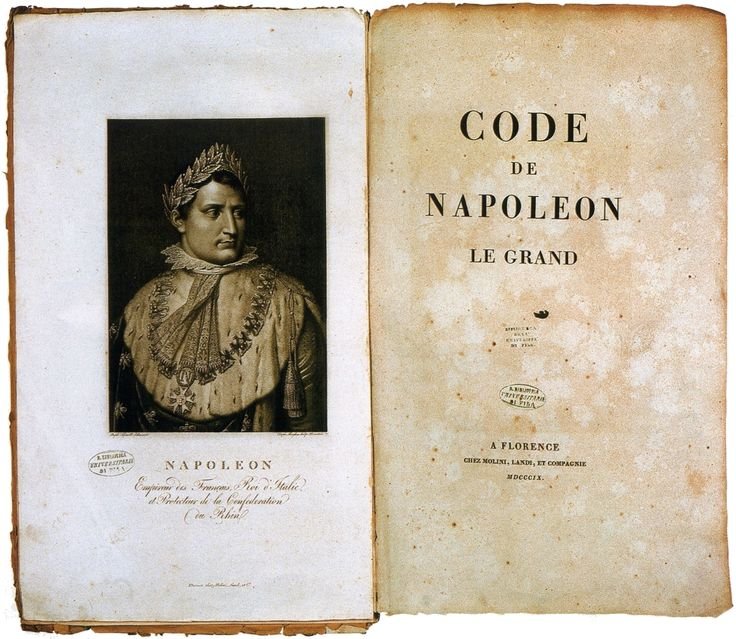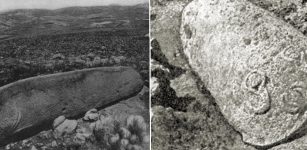Napoleonic Code: Why Was One Of The Most Influential Civil Codes Flawed?
A. Sutherland - AncientPages.com - Napoleonic Code was the French Civil Code introduced under Napoleon I on 21 March 1804.
It was the first consistent set of laws concerning criminal and commercial law, property, the family, colonial affairs, and individual rights, given by Napoleon to his people living in post-revolutionary France. The Code eliminated feudalism, supported religious tolerance, and introduced other liberal European reforms.
It is a set of organized laws, considered one of Napoleon's most essential and lasting legacies. The French military commander and political leader Napoleon Bonaparte (1769–1821) was inspired by Roman law and principles of the French Revolution to create this progressive legal system,
It has been generally considered a progressive legal system reflecting broad-minded values. The Code required that for laws to be applied appropriately, secret laws were ended. Ex post facto laws were invalidated, and procedures were needed to make the application of the rules fair.
Unfortunately, colonial slavery was reintroduced. The Code was modified and widely adopted outside France in Europe and the Western Hemisphere.
However, the Napoleonic Code made the authority of men over their families stronger, deprived women of any individual rights, and reduced the rights of illegitimate children.
The Code may not have been favorable for women, historians say.
Napoleonic Code And Women
The Code made women legally and economically dependent on men. Women acquired their husbands' nationality upon marriage and had to reside where their husbands desired. The Code guaranteed the supremacy of the man over his wife and children; the husband was the ruler of the household.

Code de Napoleon Le Grand/ The Napoleonic Code. Source
In "Changing Lives: Women in European History Since 1700", Bonnie G. Smith writes:
"Women could not participate in lawsuits or serve as witnesses in court or as witnesses to civil acts such as births, deaths, and marriages. Such a reduction in a woman's civil status enhanced that of the individual male.
Moreover, the Code reduced, if not eliminated, male accountability for sexual acts and thrust it squarely on women. For example, men were no longer susceptible to paternity suits or legally responsible for the support of illegitimate children.
Economically, women were weakened if they bore illegitimate children. Men, on the other hand, were not so affected if they fathered them. Finally, female adultery was punished by imprisonment and fines unless the husband relented and took his wife back.
Men, however, suffered no such sanctions unless they brought their sexual partners into the home. The sexual behavior of women was open to scrutiny and prescribed by law, whereas that of men, almost without exception, had no criminal aspect attached to it.
Thus, "male sexuality was accepted with few limitations, but women's was only acceptable if it remained within strict domestic boundaries." (Bonnie G. Smith, Changing Lives: Women in European History Since 1700)
The abolition of divorce by mutual consent amounted to a significant regression for French women.
- A woman cannot contract a new marriage until ten months have elapsed from the dissolution of the preceding marriage.
- The wife may demand a divorce on the ground of adultery in her husband when he shall have brought his concubine into their shared residence.
- The married parties may reciprocally demand divorce for outrageous conduct, ill-usage, or grievous injuries, exercised by one of them towards the other. 1
As the Napoleonic Code strongly influenced many legal systems in Europe and the New World, it also set the terms for treating women widely. Napoleon was pleased that his new laws had been spread throughout the empire, and said late in his life:
'Waterloo will wipe out the memory of my forty victories, but that which nothing can wipe out is my Civil Code. That will live forever.'
An original copy of the Napoleonic Code is stored in the Historisches Museum der Pfalz in Speyer, Germany.
Written by – A. Sutherland - AncientPages.com Senior Staff Writer
Updated on January 1, 2024
Copyright © AncientPages.com All rights reserved. This material may not be published, broadcast, rewritten or redistributed in whole or part without the express written permission of AncientPages.com
Expand for referencesReferences:
Smith B. G. The Oxford Encyclopedia of Women in World History
- Philip G. Dwyer, Napoleon and Europe
More From Ancient Pages
-
 Number ‘Seven’: Mystical Number Of The Universe And One Of The Most Sacred Numbers
Ancient Symbols | Feb 14, 2017
Number ‘Seven’: Mystical Number Of The Universe And One Of The Most Sacred Numbers
Ancient Symbols | Feb 14, 2017 -
 Archaeological Site Along The Nile Reveals The Nubian Civilization That Flourished In Ancient Sudan
Civilizations | Apr 14, 2022
Archaeological Site Along The Nile Reveals The Nubian Civilization That Flourished In Ancient Sudan
Civilizations | Apr 14, 2022 -
 Archaeologists Unearthed Alabaster Statue Of Queen Tiye In Luxor, Egypt
Archaeology | Mar 24, 2017
Archaeologists Unearthed Alabaster Statue Of Queen Tiye In Luxor, Egypt
Archaeology | Mar 24, 2017 -
 New Huge Viking Ship Discovered By Radar In Øye, Norway – What Is Hidden Beneath The Ground?
Archaeology | Apr 9, 2022
New Huge Viking Ship Discovered By Radar In Øye, Norway – What Is Hidden Beneath The Ground?
Archaeology | Apr 9, 2022 -
 Hundreds Of Undiscovered Roman Forts Revealed By Spy Satellites
Archaeology | Oct 27, 2023
Hundreds Of Undiscovered Roman Forts Revealed By Spy Satellites
Archaeology | Oct 27, 2023 -
 Why Are Statues Of Mythical Yeti Dividing People In The Himalayas?
Featured Stories | Feb 18, 2020
Why Are Statues Of Mythical Yeti Dividing People In The Himalayas?
Featured Stories | Feb 18, 2020 -
 Mysterious Mummified Woman With A Christian Cross On Her Chest Dashes Hopes Of Finding First Russian Fortress In Yakutia
Archaeology | Dec 12, 2019
Mysterious Mummified Woman With A Christian Cross On Her Chest Dashes Hopes Of Finding First Russian Fortress In Yakutia
Archaeology | Dec 12, 2019 -
 Viking Funeral Traditions: Burning Ships, Complex Ancient Rituals And Incredible Up Helly Aa Festival
Ancient Traditions And Customs | Jan 28, 2017
Viking Funeral Traditions: Burning Ships, Complex Ancient Rituals And Incredible Up Helly Aa Festival
Ancient Traditions And Customs | Jan 28, 2017 -
 On This Day In History: King Tut’s Tomb Is Unsealed And Opened – On Feb 16,1923
News | Feb 16, 2017
On This Day In History: King Tut’s Tomb Is Unsealed And Opened – On Feb 16,1923
News | Feb 16, 2017 -
 Rare ‘Polishing Boulder’ Used By Stone Age People Found In Dorset, UK
Archaeology | Aug 26, 2023
Rare ‘Polishing Boulder’ Used By Stone Age People Found In Dorset, UK
Archaeology | Aug 26, 2023 -
 Mysterious 2000-Year-Old Carved Vishap Stone Monuments Of Armenia
Featured Stories | Dec 13, 2016
Mysterious 2000-Year-Old Carved Vishap Stone Monuments Of Armenia
Featured Stories | Dec 13, 2016 -
 Valhalla – The Hall Of The Fallen Where Viking Hero Warriors ‘Einherjar’ Dwell After Death
Featured Stories | Mar 11, 2018
Valhalla – The Hall Of The Fallen Where Viking Hero Warriors ‘Einherjar’ Dwell After Death
Featured Stories | Mar 11, 2018 -
 Tavern And Mysterious Tools Discovered In North Carolina – Stunning Ancient Time Capsule
Archaeology | Jun 19, 2019
Tavern And Mysterious Tools Discovered In North Carolina – Stunning Ancient Time Capsule
Archaeology | Jun 19, 2019 -
 Magnificent Interior Of The Djoser Pyramid Revealed In Stunning Images And Video
News | Mar 14, 2020
Magnificent Interior Of The Djoser Pyramid Revealed In Stunning Images And Video
News | Mar 14, 2020 -
 Ancient Mystery In The Alpes Remains Unsolved Because Of Contradicting Information
Ancient Mysteries | May 15, 2018
Ancient Mystery In The Alpes Remains Unsolved Because Of Contradicting Information
Ancient Mysteries | May 15, 2018 -
 Researchers Develop New Ways Of Visualizing Ancient Small Objects By Combining Technologies
Archaeology | Apr 20, 2022
Researchers Develop New Ways Of Visualizing Ancient Small Objects By Combining Technologies
Archaeology | Apr 20, 2022 -
 Strange Ancient And Medieval Encounters With Unusual Beings Reported And Documented
Featured Stories | Jan 15, 2024
Strange Ancient And Medieval Encounters With Unusual Beings Reported And Documented
Featured Stories | Jan 15, 2024 -
 Gigantic Unfinished Stone Structures Cut With Amazing Stone-Working Techniques
Civilizations | Sep 21, 2015
Gigantic Unfinished Stone Structures Cut With Amazing Stone-Working Techniques
Civilizations | Sep 21, 2015 -
 Mysterious 3,200-Year-Old Hittite Map Of The Cosmos And The 12 Gods
Archaeoastronomy | Jul 2, 2021
Mysterious 3,200-Year-Old Hittite Map Of The Cosmos And The 12 Gods
Archaeoastronomy | Jul 2, 2021 -
 Mystery Of The Ancient Reptilian Gods Remains A Complex Subject – Memories Of The Past – Part 1
Ancient Mysteries | Feb 6, 2022
Mystery Of The Ancient Reptilian Gods Remains A Complex Subject – Memories Of The Past – Part 1
Ancient Mysteries | Feb 6, 2022

